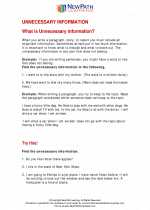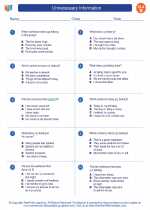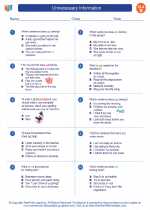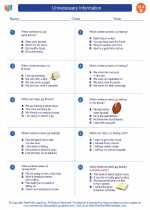Unnecessary Information
Unnecessary information refers to details or facts that are not relevant to the main idea or purpose of a text. When reading or writing, it's important to identify and filter out unnecessary information to focus on the essential points.
Identifying Unnecessary Information
Here are some strategies to help identify unnecessary information:
- Focus on the main idea: Determine the central theme or purpose of the text. Any details that do not directly support or contribute to the main idea can be considered unnecessary.
- Look for repetition: Sometimes, writers include redundant information that does not add value to the text. Identifying and removing repetitive details can help streamline the content.
- Consider the reader's needs: Think about the target audience and what information would be most relevant and useful to them. Details that do not serve the reader's understanding or engagement with the text may be unnecessary.
- Separate facts from opinions: Focus on objective, factual information rather than personal opinions or extraneous commentary.
Study Guide
Use the following questions and activities to practice identifying unnecessary information:
Reading Practice:
- Read a short passage or article and underline any details that seem irrelevant to the main topic or message.
- Discuss with a partner or group which details could be considered unnecessary and why.
Writing Practice:
- Write a brief paragraph on a familiar topic, such as your favorite hobby or a recent vacation. After writing, review the paragraph and identify any unnecessary details that could be removed to make the writing more focused.
- Share your paragraph with a classmate and ask for feedback on whether the details support the main idea effectively.
By practicing these strategies and activities, you can become more adept at recognizing and eliminating unnecessary information in both your reading and writing. This skill will help you communicate more clearly and effectively in various contexts.
Remember, identifying unnecessary information is about honing in on the essential details that support the central message or purpose of a text.
[Unnecessary Information] Related Worksheets and Study Guides:
.◂English Language Arts Worksheets and Study Guides Second Grade. Unnecessary Information

 Worksheet/Answer key
Worksheet/Answer key
 Worksheet/Answer key
Worksheet/Answer key
 Worksheet/Answer key
Worksheet/Answer key
